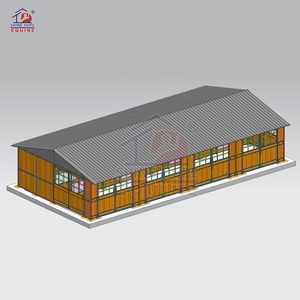
All categories
Featured selections
Trade Assurance
Buyer Central
Help Center
Get the app
Become a supplier

(1912 products available)




















































Portable horse shelters come in various types, each designed to meet specific needs and preferences. Here are some common types:
Pop-Up Shelters
Pop-up portable horse shelters are designed for convenience and ease of use. These shelters are typically made from durable fabric or material supported by lightweight poles or frames. They can be quickly assembled and disassembled, allowing horse owners to set up a shelter in minutes. Pop-up shelters are ideal for temporary use, such as at horse shows, events, or when traveling. They provide horses with immediate protection from the elements and a comfortable place to rest.
Collapsible Shelters
Collapsible portable horse shelters are designed for portability and ease of transportation. These shelters can be folded down into a compact size for easy storage and transportation. They are typically made from durable materials and provide horses with adequate shelter and protection from the elements. Collapsible shelters are popular among horse owners who need a portable shelter they can easily transport and store.
Temporary Fencing Shelters
Temporary fencing shelters are a combination of portable shelters and temporary fencing. These shelters consist of a covered area enclosed by temporary fencing panels. They provide horses with a sheltered area to stand under and graze. Temporary fencing shelters are ideal for horse owners who need a portable shelter that can also serve as a grazing area for their horses.
Trailer-Mounted Shelters
Trailer-mounted portable horse shelters are mounted on horse trailers for easy transportation. These shelters are made from durable materials and are attached to a metal frame. They provide horses with a secure and sheltered area to rest during transportation and at horse shows or events. Trailer-mounted shelters are popular among horse owners who need a permanent and secure shelter for their horses.
Portable horse shelters serve a variety of purposes and can be utilized in different scenarios. Here are some key usage scenarios:
Business owners should consider various factors when selecting a portable horse shelter for resale. Here are some key factors:
Durability
Buyers should look for horse shelters made from durable materials that can withstand various weather conditions. They should also ensure the materials are resistant to rust, rot, or corrosion.
Size and Space
The portable horse shelters come in different sizes. Therefore, buyers should get options that can accommodate different sizes of horses. More importantly, they should ensure the shelters provide enough space for horses to move around.
Ease of Transport
The horse shelter is portable, meaning it can be easily moved from one place to another. Therefore, buyers should look for horse shelters that are lightweight and easy to assemble and disassemble.
Ventilation
Proper ventilation is essential for a horse's health. Buyers should ensure the horse shelter has adequate ventilation while providing protection against harsh weather elements.
Customization Options
To attract a wide range of customers, buyers should get portable horse shelters with customization options. Such shelters should allow horse owners to add personal touches or modify the shelter to suit their specific needs.
Ease of Maintenance
Portable horse shelters require regular maintenance. Therefore, buyers should look for shelters that are easy to clean and have materials that do not require frequent upkeep.
Weather Protection
Portable horse shelters provide horses protection from adverse weather conditions. They keep horses safe from burning sun, rain, snow, and chilly winds. Horses can stay comfortable inside the shelter in any weather. They can also avoid stress-related health issues.
Safety and Security
The shelter protects the horses from predators. It also provides a safe space for horses to rest and relax.
Convenience
The portable horse shelters are easy to move around. They are also easy to assemble and disassemble.
Durable Materials
Most portable horse shelters are made from high-quality and long-lasting materials like steel and heavy-duty plastics. These materials can withstand harsh weather conditions.
Ventilation
Horse shelters have open sides or roofs that allow fresh air to circulate inside. Good ventilation is crucial for keeping horses healthy.
Adjustable Sizes
Some portable horse shelters come with adjustable sizes. Horse owners can adjust the size of the shelter to suit their needs.
Easy Access
Most horse shelters have large doors or openings that provide easy access for horses, feeders, and caretakers.
Lightweight Frame
The portable horse shelters have a lightweight frame that makes them easy to move around.
Easy Assembly
Most portable horse shelters come with pre-drilled holes and easy-to-follow instructions. They can be assembled within minutes.
Portable Feet or Base
Some portable horse shelters have feet or a base that makes them easy to move around.
Q1: Can these shelters be moved easily?
A1: Yes, as the name indicates, portable horse shelters are designed to be moved easily. They are constructed using lightweight materials and have a modular design that makes relocation simple and efficient.
Q2: How are the portable horse shelters anchored?
A2: The portable horse shelters can be anchored using ground anchors or weights. The anchors or weights ensure that the shelters remain stable and do not get moved by strong winds.
Q3: How many horses can a portable shelter accommodate?
A3: The size of a portable shelter determines the number of horses it can accommodate. Generally, the shelters range from 100 square feet to 300 square feet. A good rule of thumb is to have 100 square feet for each horse.
Q4: Can the portable horse shelter be customized?
A4: Yes, the portable horse shelters can be customized to meet specific needs. Buyers can request additional features such as windows, venting systems, and various configurations.
Q5: Are the portable horse shelters durable?
A5: The durability of the portable horse shelters will depend on the quality of materials used. High quality shelters are made from heavy duty materials such as galvanized steel, aluminum, and high-density plastics.